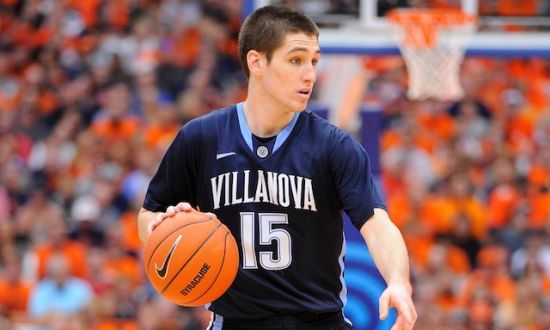Despite Conference Realignment, Syracuse vs. Villanova Here to Stay
Posted by Joe Dzuback (@vbtnblog) on December 23rd, 2014Joe Dzuback is the RTC correspondent for the Atlantic 10 Conference. You can also find his musings online at Villanova by the Numbers or on Twitter @vtbnblog.
It’s Northeast basketball. It used to be what the Big East was, but it’s still Northeast basketball. It’s a great rivalry. The fans know each other… — Jay Wright, Villanova head coach, 12/20/2014.
Syracuse has played basketball since 1899, but did not join a conference (the Big East) until 1979. Among the colleges and universities across Pennsylvania, New Jersey, New York and the six New England states, stable conferences like the Ivy League (1902-present) were, before the late 1970s, the exception rather than the rule. Schools either remained stubbornly independent (Boston College, Duquesne, Holy Cross, Penn State, Providence, St. Bonaventure, and Villanova, for example) or, like Fordham — which belonged to the Metro NY Conference (1933-34, 1936-39, 1942-43, 1946-63), the NJNY7 (1977-79), the East Coast Athletic Metro Conference (1980-81), the MAAC (1982-90), and the Patriot (1991-95) before finally settling into the Atlantic 10 (1996-present) — flirted with conference affiliations like Taylor Swift dangles musicians and actors. Too many of these conferences — the Eastern Intercollegiate Conference (1933-39), the Middle Three Conference (1949-52), the Little Three Conference (1947-58) and the New Jersey-New York 7 Conference (1977-79) — modeled on Philadelphia’s Big 5 series and little more than commitments to schedule round-robin play — had little in the way of longevity. The NCAA, which began its postseason invitational tournament to crown a champion in 1939, paid little attention to the region’s conference comings and goings. The influence of Marquette’s Al McGuire and CBS Sports changed all of that.
“We’re [Syracuse] going to play two non-conference games each year, plus the ACC/Big Ten… thing, so we’re going to have three of these games and play in (an invitational)… tournament. So should we play — Illinois or Kentucky or “somebody” — or should we play teams that we have always played? It’s [Syracuse-Villanova] a great rivalry. They are great games.” — Jim Boeheim, Syracuse head coach, 12/20/2014.
Despite a record of 23-3 and #8 national ranking, the NCAA offered Marquette, Milwaukee’s small Jesuit college, a “play-in” game in Texas. Sixth-year head coach McGuire, insulted by the offer, instead declined and took his Warriors to New York City’s National Invitational Tournament. There his squad swept the field, beating St. John’s by 12 points in front of 19,500 fans at Madison Square Garden. Message received by the NCAA — the next 10 Marquette teams received bids, with the school winning its only National Championship on McGuire’s seventh consecutive trip in 1977. The NCAA decided to expand the Tournament field several times during the 1970s, eventually offering at-large bids to qualified teams after top-five Maryland was left out of the field in 1974 (NC State won the ACC title). With CBS’ 1982 television contract in place, the media organization wanted to guarantee that there would be no more “Marquettes” that escaped the clutches of the NCAA Tournament to draw attention elsewhere. The NCAA obliged by requiring any invited school to accept their bid, guaranteeing every Division I conference winner a place in the field, and expanding the field again (to 48 teams, on the way to 64-then-68).

As a perfect example to this great rivalry, Ryan Arcidiacono and Villanova squeaked out a much deserved victory over the Orange last weekend. (USA TODAY Sports)
“I don’t like it when they have a lead at the end and their fans are chanting ‘Let’s go Orange’, but I know our people get fired up when they come in here and when their fans come in here. That makes for an incredible atmosphere… Syracuse and Villanova, it’s the same thing… no matter who coaches here it’s the same thing. I think we really have to appreciate that…” — Wright, 12/20/2014.
The last Big East game Syracuse and Villanova played (Wells Fargo Center; January 26, 2013), Wildcats’ point guard Ryan Arcidiacono sank a three to send the game to overtime, which Villanova went on to win. The rivalry was renewed with a game at the Carrier Dome last season when #8 Villanova swept into the Dome to take on #2 Syracuse. The Wildcats ran out to a 25-7 lead in the game’s first nine minutes, but the Orange roared back to shred Villanova’s defense and outscore the Wildcats by 34 points over the last 31 minutes en route to a 78-62 thrashing. Saturday’s game, with 18,000+ fans packing the Wells Fargo Center in downtown Philadelphia, was a fitting complement to the previous two, as Villanova, trailing for the entire game, scored five quick points in 13 seconds to tie the game and send it to overtime. With 17 seconds on the clock, Arcidiacono drove into the paint and dished to a wide-open Josh Hart at the three-point line to cut the lead to two. On the next play, JayVaughn Pinkston tipped an inbounds pass intended for Rakeem Christmas and triggered a melee for the loose ball. Arcidiacono got there first, however, and with three Orange players again converging on him, he found Pinkston flashing on the baseline to convert easily on a reverse layup. Syracuse heaved a prayer from beyond the top of the key and the game rolled into overtime which Villanova finished off, 82-77.
“Last year we played St. John’s and Villanova and we won. I liked that a lot better, but it doesn’t work that way all the time. But it’s a great game, a great rivalry.” — Boeheim, 12/20/2014.










































